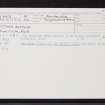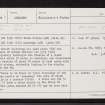Nether Balfour
Hut Circle (Prehistoric)(Possible), Souterrain (Prehistoric)(Possible), Stone Circle (Neolithic) - (Bronze Age)(Possible)
Site Name Nether Balfour
Classification Hut Circle (Prehistoric)(Possible), Souterrain (Prehistoric)(Possible), Stone Circle (Neolithic) - (Bronze Age)(Possible)
Alternative Name(s) Braes Of Forbes
Canmore ID 17574
Site Number NJ51NW 5
NGR NJ 5392 1720
Datum OSGB36 - NGR
Permalink http://canmore.org.uk/site/17574
- Council Aberdeenshire
- Parish Tullynessle And Forbes
- Former Region Grampian
- Former District Gordon
- Former County Aberdeenshire
NJ51NW 5 5392 1720
See also NJ51NW 12.
(NJ 5392 1720) Stone Circle (NR) (Site of)
(NJ 5393 1722) Causeway (NR) (Site Of)
OS 6" map, (1959)
Whilst improving his land about 1847 the tenant of Nether Balfour (NJ 5373 1738) completely destroyed the remains of a stone circle about 20 yards in diameter, and discovered the remains of about 20 yards of road paved with flat stones, evidently leading to the circle, from the NE.
Name Book 1867.
There is no trace or local knowledge of the stone circle or 'causeway' the site of which falls in a pasture field. A stone cup (NJ51NW 12) from a stone circle on the Braes of Forbes (area centred NJ 53 17) may be from this site.
Visited by OS (RL) 10 September 1968.
There is no change to the existing record.
Information from RCAHMS (JRS), 26 August 1996.
Publication Account
In 1867 OS surveyors noted the site of what they termed a Stone Circle in a field 250m south-east of Nether Balfour (Aberdeenshire 1869, lxii). It had been removed some 20 years before and measured about 18m in diameter, with what was described to them as ‘the remains of about 20 yards [18.3m] of road paved with flat stones, evidently leading to the circle, from the NE’ (Name Book, Aberdeenshire, No. 88, p 107). Annotated Causeway on the map, this was one of a number of such features that they had been told about, in every case adjacent to a Stone Circle – Bankhead (NJ52NW 25); Crookmore (NJ51NE 16 and NJ51NE 144); Druidsfield (NJ51NE 1); and Newbigging (NJ52NW 10). At both Druidsfield and Newbigging, Coles was persuaded that these had been rings with recumbent settings, but it was Alexander Keiller who then drew a connection between causeways and recumbent stone circles, thus drawing Nether Balfour into this category (1934, 18). Without any visible remains to contradict this identification, the inclusion of these structures in lists of possible and probable recumbent stone circles has been inevitable (Burl 1970, 78; 1976a, 352, Abn 79; 2000, 421, Abn 82; Ruggles 1984, 59; 1999, 187 no. 53). However, the most recent analysis of the descriptions of these monuments suggests an alternative explanation. Rather than rings of freestanding orthostats, they were all (excepting Druidsfield) probably walled enclosures or hut-circles with attached souterrains of the type that can still be seen at New Kinnord in the Howe of Cromar (Gannon et al 2007, 70–1).










